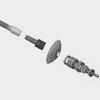Weichteilsarkom-Chirurgie
- Startseite
- Sarkom-Chirurgie
- Weichteilsarkom-Chirurgie
SOFT TISSUE SARCOMA: BETTER LIFE EXPECTANCY
Until relatively recently, having a soft tissue sarcoma in a limb was synonymous with amputation and a high probability of dying from the spread of the disease.
In recent decades, improvements in chemotherapy and radiotherapy treatments, and, above all, the management of these tumours by multidisciplinary teams in reference hospitals, have led to a substantial improvement in both life expectancy and a decrease in the rate of amputations that were once practiced.
Enneking and collaborators came to demonstrate in the 1980's that "limb sparing surgery" was possible when it was performed by a surgeon with sufficient experience in the surgical management of sarcomas, following some basic principles described in this section.
Biological behavior of soft tissue sarcomas
The embryonic mesodermal origin of these tumours means that they are classified by virtue of the mature tissue they resemble. This origin also determines a different biological behaviour than that of the carcinomas. In fact, sarcomas tend to grow centrifugally at greater or lesser speeds depending on factors that are not well known, such as the host and other intrinsic factors of the tumour, such as the histological grade and its anatomical location. A high-grade sarcoma located in the thigh can double or triple in size within a few weeks.
Sarcomas are solid masses, although they may contain areas of necrosis within them (especially those that are rapidly growing). Typically, the peripheral region is the most immature and is not surrounded by a true capsule as in benign tumours, but rather by a reactive zone composed of a thin layer of mature fibrous tissue and a layer of varying thickness formed by the local reaction of the tumour. Since this reactive zone contains tumour cells, it is also called a "pseudocapsule". If the surgeon does not know this particular behaviour to which we refer and tries an exeresis thinking that the tumour is contained inside a capsule, he will leave in the surgical bed part of the reactive zone containing neoplastic cells and local recurrence will be guaranteed. In addition, intraoperative bleeding, in case of violating the integrity of the tumour, is unfailingly contaminated by tumour cells, so that the dispersion of the hematoma by the surrounding tissues and sometimes further away could have catastrophic consequences that make it impossible to preserve the limb.
Unlike carcinomas, which grow by invading any tissue around them, soft tissue sarcomas respect so-called anatomical barriers. They grow progressively and stop for a variable amount of time when they reach these "anatomical barriers," such as the periosteum, fascia, or epineuro of a nerve. They continue their growth by expanding through the compartment in which they are housed, looking for the area of least resistance. Only in later phases do they infiltrate and break down these barriers, invading the neighbouring compartment, penetrating the bone, etc. This is of vital importance and has its surgical consideration, as it can be used by the surgeon to mark a limit of resection or to save a vascular or nervous structure if these are not completely encompassed by the tumoural mass.
On rare occasions, the sarcoma may "skip" the area defined by the pseudocapsule and produce satellite lesions or "skip metastases" that are typically located in an apical or distal direction following the longitudinal axis of the limb.
Contact Dr. Oscar Tendero auf Mallorca and find out what services we can offer you in sarcoma surgery.
IHRE ERSTE GESUNDHEIT

GEIS-Knochentumor-Treffen

Integrierte endo-exo Oberschenkelprothese
BERATUNG
Hospital Juaneda Miramar
Camí de la Vileta, 30
07011 Palma
971 280 000


